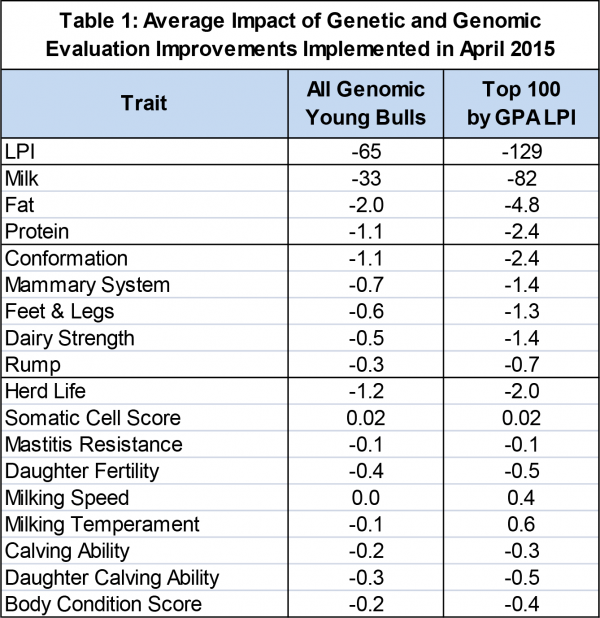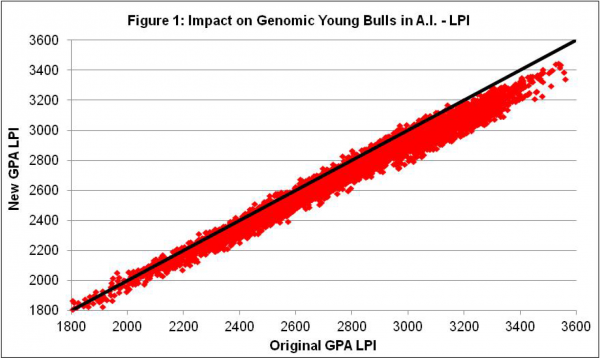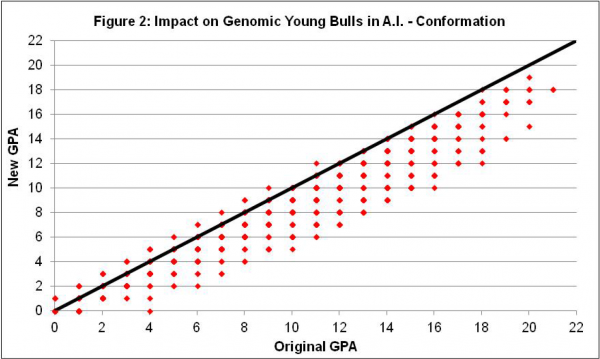The April 2015 genetic evaluation release will include various improvements officially introduced by Canadian Dairy Network (CDN). The combined impact of these changes, which will vary from trait to trait, will be especially important for genomic young bulls and genotyped heifers. What has changed and how should you adjust your selection decisions accordingly?
What has Changed?
In April of each year, CDN updates the genetic base used for the expressing of Canadian genetic evaluations to account for the annual rate of genetic progress for each trait. In addition to this usual adjustment associated with the upcoming genetic evaluation release in April 2015, CDN will also be introducing the following improvements to various components of its genetic and genomic evaluation calculations:
- The Canadian Test Day Model for production traits has been enhanced to allow for different shapes of lactation curves from herd to herd, which can also change over time within a herd. Herd management practises and environmental effects can affect production levels differently throughout the lactation and therefore affect the shape of lactation curves. This adjustment, which has shown to provide more accurate sire proofs for production traits, will have an important impact on cow evaluations in some herds while other herds will be less affected.
- The calculation of indexes and associated Reliabilities for Daughter Fertility, Calving Ability and Daughter Calving Ability has been improved in a manner that provides consistency between sires proven domestically and foreign sires with a MACE evaluation in Canada.
- The prediction for Indirect Herd Life has been updated following the introduction of Mastitis Resistance and Body Condition Score as newly evaluated traits in recent years.
- For the calculation of genomics, the methodology for de-regressing sire proofs has been significantly improved such that foreign sires with a MACE evaluation contribute to the estimation of genomic evaluations in a manner more consistent to the contribution from domestically proven sires. An important consequence of this new methodology is that it significantly reduces the current over-estimation of genomic young bulls and heifers compared to proven sires and cows.
Although most of the improvements above are specific to certain traits, the enhanced procedure for proof de-regression affects genomic evaluations for all traits to one degree or another.
Impact on Genomic Young Bulls
To demonstrate the impact of these improvements, which will be observed with the April 2015 release, Table 1 shows the average change for all North American genomic young bulls as well as for the Top 100 based on GPA LPI. For most traits, the average impact across all genomic young bulls is relatively small although an overall decrease is observed for production and major type traits as well as Herd Life, which translates to an average LPI drop of 65 points. The average change is more important, however, for high genomic young bulls as indicated by the Top 100 GPA LPI bulls in Table 1. For LPI, these bulls experience an average decrease of 129 LPI points and the traits that drop the most include Conformation, Herd Life, the other major type traits and Fat yield. Similar changes can be expected for genotyped heifers so breeders will have to adjust their criteria for evaluating and selecting the most elite genomic young bulls and heifers in the breed.

Figure 1 shows the relationship for LPI values before and after the April 2015 improvements to the genetic and genomic evaluations, with the dark diagonal line representing values that are equal in each case. The impact of these changes is quite clear with essentially all of the highest genomic young sires reducing to some degree, which is roughly 3% on average for bulls over 3000 GPA LPI and about 2% for bulls between 2500 and 3000. Among genomic young bulls currently over 3000 GPA LPI, essentially 99% will decrease due to the improvements implemented in April with the most extreme changes being as high as -250 LPI points.

Since Conformation is the trait most affected by the improvements introduced in April 2015, Figure 2 shows the relationship between the before and after genomic evaluations for genomic young bulls in A.I. that are positive for Conformation. As expected, the new methodologies implemented by CDN will reduce the over-estimation of young bulls compared to proven sires and a similar impact will been seen for genotyped heifers. While the average change for the Top 100 GPA LPI young bulls is -2.4 for Conformation (Table 1), the most extreme decreases will be 4 points or more. In addition to this impact, the genetic base update to be implemented in April is expected to result in an overall decrease of close to one point for Conformation for all animals.

Summary
A fundamental principle and mandate of CDN is to provide the most accurate genetic evaluations possible for all dairy breeds in Canada. The arrival of genomics over five years ago has increased the challenges associated with this key objective. CDN geneticists have worked hard in recent years to identify improvements to methods used to calculate traditional genetic evaluations as well as genomic evaluations. Through the process of research and presentation of results to industry partners, various genetic and genomic evaluation improvements will be implemented in April 2015 in addition to the usual annual genetic base update. These improvements have shown to provide more accurate evaluations going forward but will result in a significant one-time adjustment that especially impacts elite genomic young bulls and genotyped heifers. Breeders and industry organizations must adjust their criteria and selection decisions according to the narrowed scale of genomic evaluations at the extreme levels.
Source: CDN









